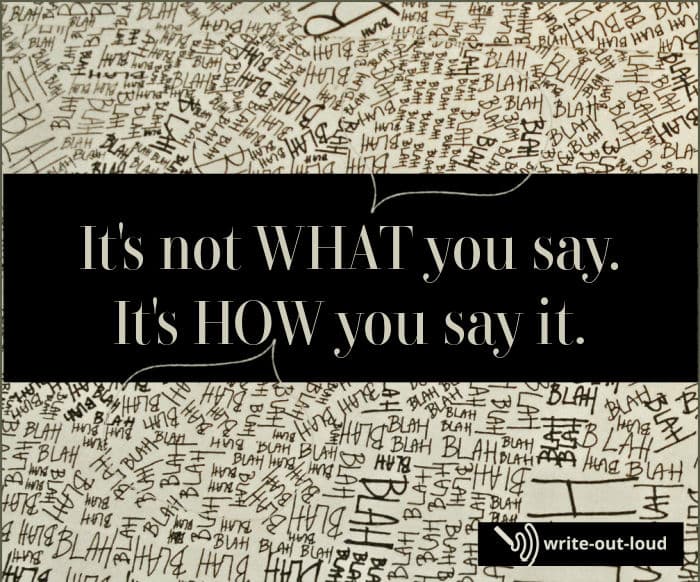- HOME ›
- Speech delivery
What is delivery in speech?
The 2 basic principles of effective speech delivery and how to excel in both of them
By: Susan Dugdale
Speech delivery is not WHAT you say, but HOW you say it. It's a catch-all term covering all the elements that make up giving a speech.
These include:
- the style or method you select to use to give your speech
- vocal aspects: how you use your voice
- personal presentation aspects: how you dress for the occasion, how you move and gesture, how you make eye contact, and how you use visual aids
Use the index below to find out more about how to deliver a good speech.
What's on this page
- The 2 basic principles of effective speech delivery
- Speech delivery for different situations - 4 modes of speech delivery: manuscript, memorized, extemporaneous, impromptu
- Tools for effective speech delivery
- 9 vocal aspects of speech delivery: a comprehensive overview
- Specific vocal aspects of delivery with exercises: vocal variety, speech rate, diction (articulation) exercises, pronunciation, how to use pauses effectively and voice health
- The physical aspects of speech delivery
- Exercises to work with breath, body language, eye contact and characterization for storytelling
- Plus personal grooming - a self-presentation checklist and how to practice a speech - the rehearsal process
- 9 vocal aspects of speech delivery: a comprehensive overview
- How to manage public speaking anxiety

2 basic principles of effective speech delivery
The two basic principles underlying effective speech delivery are simple.
- that the speaker uses the most appropriate delivery style or method for the speech content, its purpose and its audience
- that audience engagement is highest when a speaker has thoroughly prepared and practiced
A speech is successful when the speaker fulfills both of them.
Speech delivery for different situations
There are four basic styles or methods of speech delivery: manuscript, memorized, extemporaneous, and impromptu.
Each has its place. Which one you choose to use depends on the type of information you have to deliver, your speech purpose, the context or setting for it, your audience's expectations and needs, the time you have available to prepare the speech, and your own capabilities as a speaker.
Manuscript speeches
A manuscript speech is one that has been completely scripted: word for word, sentence by sentence, from beginning to end. It is read by the speaker, either from notes on paper or from a teleprompter.
Manuscript speeches are used by anybody whose words are going to be closely scrutinized and need to be 100% accurate, for example: newscasters, government and public service officials.
And they're also used by people who don't have the time available to thoroughly practice giving their speech any other way, and those who are speaking at an emotional occasion (for example a wedding or funeral) and don't want to run the risk of finding themselves overcome and literally at a loss for words.
Memorized speeches
A memorized speech is entirely committed to memory and delivered verbatim - word for word as written. To be successful you must have plenty of time to do the work required. Knowing a speech so thoroughly that you don't need to think about what comes next gives a speaker complete freedom to specifically tailor the delivery for the audience. That's a great experience!
Extemporaneous speeches
An extemporaneous speech is one combining the use of speaking notes (an outline or cue cards) with key words and phrases for reference, and unscripted speech. It is the most common delivery style.
Although it may appear impromptu, it is not. To be effective the speaker will have rehearsed the speech carefully, particularly the transitions or links between points.
Impromptu speeches
An impromptu speech is one that is 'made up on the spot', generally without planning. These are mostly short and although they are often social speeches: for example, a welcome to an event, a toast, or a few words of thanks, they are also asked for in our workplaces. Examples are being requested at a meeting to quickly summarize current team issues, to give an overview of the state of the latest project etc.
For more information about each style please see: 4 modes of speech delivery.
Tools for effective speech delivery
Use the links to find out more about the techniques and tools needed for developing good speech delivery.
The 9 vocal aspects of speech delivery
This is a very long page covering the impact of voice quality on our lives, (how what we sound like in the ears of others affects what happens in our lives), the nine vocal aspects of speech delivery, (pitch, tone, articulation, pronunciation, volume, rate, fluency, pausing, and breath), and how to work with each of them. (Plus scholarly references.)
Specific vocal aspects of delivery with exercises
Voice image: how the quality of our voices is a major influence on what happens in our lives and the character traits we attribute to a person because of how their voice sounds. With links to scholarly research articles.
Vocal variety: pitch (how high or low our voice is and its range), tone (the emotional content conveyed by how the words are spoken eg. lovingly, angrily, shyly ...) and volume (how loud or soft our voice is).
Speech rate: how speech rate (talking too fast or too slowly) affects listeners, how to develop a flexible speaking rate to fit the needs of your content and those listening to you, six exercises.
How to calculate your own habitual speech rate: two ways to find out how fast you speak, speech rate guidelines, plus a standard test passage printable.
How many words per minute in a speech: a quick reference guide for the number of words needed for 1 - 10 minute speeches delivered at a slow, medium or fast speech rate.
Diction exercises: 35 articulation drills using tongue twisters, with audio examples.
Mrs Tongue Does Her Housework: a sequence of tongue stretches for improving agility and accuracy set to a simple story. An evergreen exercise that's been used by speech therapists and drama teachers for years!
Proper pronunciation: an overview of the possible consequences of mispronouncing common words and phrases. With links to truly excellent resources to assist with pronunciation issues.
How to use silence effectively: harnessing the power of the pause - the benefits of using pauses for both the speaker and the audience. An easily learned 'counting' method for working where pauses should be used, and how long to make them. With audio examples.
Voice health: how to look after your voice and keep it healthy. Very important for teachers, salespeople, call center workers - anybody who uses their voice in order to work.
The physical aspects of speech delivery
Breath: to deliver a speech well we need to breathe well which in turn will also help to control nervousness or anxiety about speaking in front of others. These exercises are easy to do and very effective.
Body language: how stance, gesture, facial expressions, eye contact, movement around the stage etc., influences how an audience responds to a speaker.
Eye contact: 5 exercises for teaching and practicing eye contact, the importance and meaning of eye contact, cultural differences - plus references.
Characterization for storytelling: an introduction to taking on physical and vocal characteristics to enhance telling a story as part of a speech.
Personal grooming: a checklist for speakers because how you present yourself matters.
How to practice a speech: step by step guidelines on how to thoroughly rehearse a speech. Preparing what you are going to say is the first half of the task. Presenting it is the second, and to do that well, you need to practice.
How to practice public speaking: 9 key ways to effectively prepare for a presentation. (This page is an excellent supplement to what's covered in how to practice a speech.)
Managing public speaking anxiety
Feeling nervous prior to giving a speech is absolutely normal. Most people feel like that and then, as they get into their presentation, the anxiety disappears. But sometimes it sticks around and it takes a little more effort to send it on its way.
These pages will help.
- 14 ways to calm public speaking fear
- Breathing exercises (especially recommended!)
- Letting go of public speaking fear - a free 7 part e-course
- How to manage public speaking anxiety using self-hypnosis




